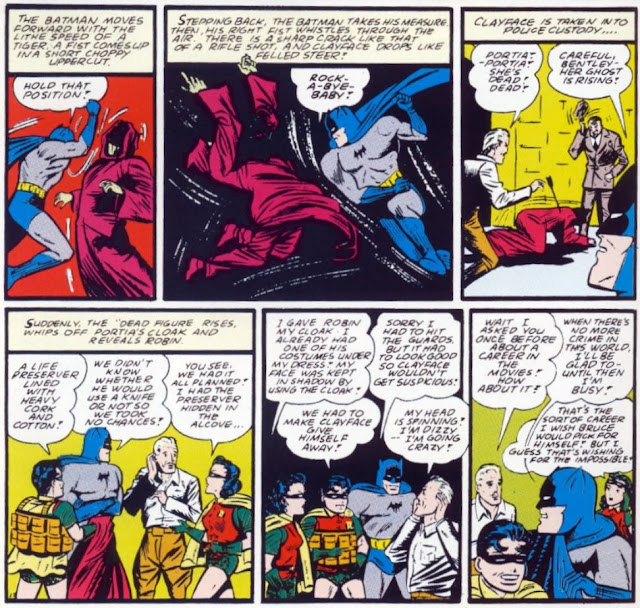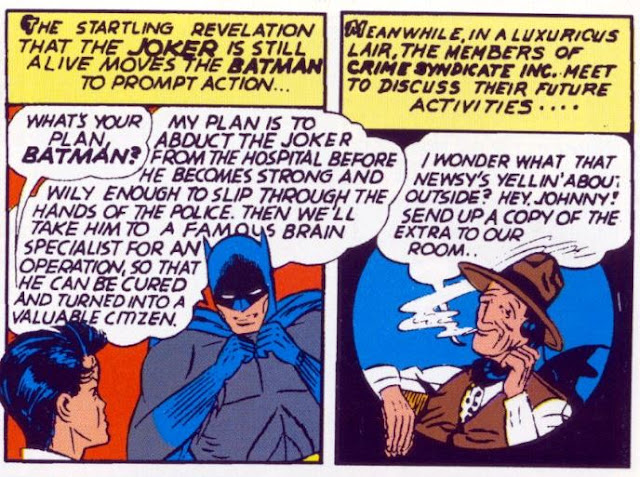What did the Joker get up to in 1940?
1. Batman Comics v1 001, 'Untitled' **first appearance**
The Joker really hits the ground running in his first crime-outing. He establishes his character - prideful, mercurial and on-theme - and methods that are still in his repertoire to this day
He indulges in the old standard of warning the police ahead of time, then killing his target and stealing their named gems (uh, this is a personal term for any gem famous enough to have a name, like the Hope Diamond. they make more frequent appearances in comics than real life, unsurprisingly). Not the most creative of crime sprees by his own eventual standard, but everyone has to start somewhere. He also murders a number of people who challenge him, including a gang boss and a judge who once sent him to jail (a perfect 1/1 judge and jury revenge slaying! Aim low, kids!).
Also established this adventure: the smiling-death style of Joker Venom, as well as:
...the classic hideous Joker calling card design.
But despite racking up an impressive success rate and almost killing both Batman and Robin on several occasions, the Joker ends his first outing in the slammer.
2. Batman Comics v1 001, 'The Joker Returns'
That's right, the Joker makes his second appearance in the same issue as his first! They knew he was a hot property from the very start!
After a very dramatic escape from prison and a relocation to his secret cemetery hideout, the Joker settles into his familiar pattern: a taunting message, then theft or the murder of his enemies. In achieving the latter, he employs two of my very favourite deathtraps in comics:
To bump off the Chief of Police: a sound-activated poison dart launcher concealed in his telephone - and he activates it by shouting his own name real loud! Tremendous style points there.
The second is just sharpened playing cars with poison on the edges, but again there's some tremendous style on display in the commitment to the bit of having an entire pack of jokers. Completely worth going around to every gaming supply store in Gotham to buy packs of the same brand of cards.
A minor point in this adventure is that it highlights that the Joker is primarily a jewel thief, something that I associate with the Golden Age version of the character but that might just be me extrapolating from this issue.
And finally we have the death of the Joker, truly one of the great on-brand death scenes of all time as he gets stabbed while struggling over a knife with Batman. It was a good run but the Joker is dead.
OR IS HE???
3. Batman Comics v1 002, 'Untitled'
Since the Joker actually survived the last issue, both Batman and the members of Crime Syndicate Inc have the same idea: kidnap him while he's being treated for his injuries, the former for some sort of gruesome lobotomy and the latter as a replacement for their recently deceased leader. More than half of the story is taken up with the dueling Joker kidnappings, after which he predictably betrays the crooks, strikes out on his own and ends up left for dead in a burning castle.
More interesting to me is that this is the end of a sequence of events that, well, here's a timeline:
-Initial Joker crime spree. No time period is specified in the story but it seems a fairly rapid-fire series of crimes. Somewhere between 1 and 2 weeks, we'll say. Joker is captured.
-Two days later, Joker escapes. His crime spree resumes at the same pace, with at least two robberies occurring sequentially. Say another 1 to 2 weeks. Joker is seriously injured and rushed to hospital.
-Crooks spirit Joker away following his treatment. His recovery lasts one week, after which he seemingly dies in a fire.
What this all adds up to is a situation like Friday the Thirteenth 2 through 4, but whereas that was an astonishingly bloody weekend told over the course of three movies, this is the Joker committing at least 6 high-profile robberies and 13 murders over the course of one to two months! A huge debut for the big guy!
4. Detective Comics v1 045, 'The Case of the Laughing Death'
Predictably, the Joker is not, in fact, dead! He remains alive to this day if you can believe it!
He has, though, adopted a brand new modus operandi. Perhaps drawing on his brief time with Crime Syndicate Inc, he slips for the first time into an alter ego with the infuriating surname of Rekoj and forms a little gang of his own. Then, after his gang pulls a heist, he robs them as the Joker so that he doesn't have to split the profits with them. IT'S A DUMB PLAN BUT IT WORKS.
I'm willing to forgive, but only because of the great deathtraps, and this is a fun one: a record that releases Joker Toxin as it plays, thus killing even as its message is delivered. Insidious!
At story's end, the Joker is in the drink, presumed dead. For good? No.
5. Batman Comics v1 004, 'The Case of the Joker's Crime Circus!'
For his final outing of 1940, the Joker assembles another gang. This time, it's one of my favourite styles of gang, the circus of crime! They specialize in casing wealthy patrons' estates and manors and then using their circus skills to rob the various joints.
Batman being Batman, he pieces together the clues and tracks down the Joker, who ends the adventure in the traditional manner by seemingly plummeting to his death.
Body Count: at least 14
End-of-year Status: Presumed Dead























































